Topics
Historiography : Development in the West
History : Applied History
Working of the Constitution
Historiography : Indian Tradition
The Electoral Process
Political Science : Working of the Indian Constitution
Applied History
Political Parties
History of Indian Arts
- What is ‘Art’?
- Indian Traditions of Visual Arts (Drik Kala): Painting
- Prehistoric Paintings
- Mural Paintings and Cave Painting
- Folk Styles of Paintings
- Classical Styles of Painting
- Miniature Paintings in Manuscripts
- Modern Indian Paintings
- Indian Traditions of Visual Arts (Drik Kala): Sculpture Art
- Indus Civilization Sculpture
- Folk Styles of Sculptural Art
- Classical Styles of Sculptural Art
- Indian Iconography
- Indian Traditions of Visual Arts (Drik Kala): Architecture and Sculpture
- Rock-cut Architecture
- Temple Architecture
- Indo-Islamic Architecture
- Indo-Gothic architecture
- Indian Traditions of Performing Arts
- Indian Theatre
- Indian Music
- Indian Dance
- Present Scenario of the Performing Arts
- Art, Applied Art, and Professional Opportunities
Social and Political Movements
- Movement
- Important Movements in India
- Tribal Movement
- Farmers Movement
- Worker's Movements
- Women’s Movement
- Environment Movements
- Consumer Movement
Mass Media and History
Challenges Faced by Indian Democracy
Entertainment and History
Sports and History
Tourism and History
Heritage Management
History - Imperialism
History - 20th Century Age of conflict
History - Emancipation of Asia and Africa
History - World after World War 2
Political Science
Geographical discoveries and colonization
- Concept for Geographical Discoveries and Colonization
Africa
- Imperialism - Africa
Asia: India, China, Japan
- Concept for Asia: India, China, Japan
Dictatorships in Europe, Second World War and world
- Concept on Dictatorships in Europe
- Concept for Second World War and World
First world war
- Concept on First World War
The League of Nations
- Concept for the League of Nations
Russian Revolution
- Concept for Russian Revolution
United Nations Organization
- Concept for United Nations Organization
Africa
- Emancipation of Africa
Asia
- Emancipation of Asia
Globalization
- Globalization After World War II
Scientific and Technological Progress
- Scientific and Technological Progress After World War II
Cold war
- Formation of the Cold War
Social Diversity and Democracy
- Social Diversity
- Coccept for Caste/Race and Democracy
- Concept for Language and Democracy
- Cocnept for Religion and Democracy
- Concept for Gender and Democracy
- Concept for Democracy and Diversity
Challenges to Democracy Remedial Measures to the Challenges
- Concept for Challenges to Democracy Remedial Measures to the Challenges
Internal work
Democracy
- Democracy - Meaning, Types and Characteristics
Political Parties and Types
- Political Parties
- Importance of Political Parties
- Major National and Regional Parties in India/ Types of Political Parties
Notes
Classical Styles of Painting:
- Classical Painting is expressed within an established frame of consistent rules which is required a long period of training to master any form of classical art.
- The third Khanda of the Vishnudharmottara Purana, a fifth-century text has a chapter Chitrasutra, which should be considered a sourcebook of Indian art in general and painting specifically. It talks about the art of image making called Pratima Lakshana, which are canons of painting.
- The Khanda also deals with the techniques, tools, material(s), surface (wall), perception, perspective, and three-dimentionality of human figures.
Six Limbs of Indian Painting Shadanga:
- The word ‘SADANGA’ consists of two words, one is ‘Shad’ means ‘Six’ & the other is ‘Anga’ means ‘Part’. Sadanga consists of the six limbs, or canons of art, on which the whole art of painting depends.
- The Sadanga is an inevitable part of every great Indian masterpiece.
- India of the 1st century B.C. had seen the evolution of the ‘SADANGA’ or the SIX LIMBS OF THE PAINTING’ which are considered as the principles of the art even today.
The Six Limbs are:
“Roopabhedah pramanani bhava-lavanya-yojanam।
Sadrishyam Varnakabhangam iti chitram shadakam॥’’
1. Roop-bheda (variation of form):
- Rupa means form and Bheda means the variation in form.
- Rupa-bheda consists in the knowledge of special characteristics of things - natural or manmade; say, the differences in appearances among many types of men, women, or natural objects or other subjects of the painting.
Example: Padmapani, Cave No. 1, Ajanta, Maharastra
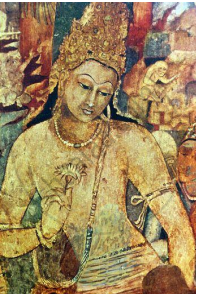
so many forms are shown. Padmapani, a representation of Buddha, stood beside the princess, attendants, musicians, kinnaras, and animals like monkeys and birds while carrying a blue lily and exuding the elegance and charm of a young king. With the architectural scene, trees, and plants in the background. as well as figures in stances and carrying out movements, each with a different colour complexion.
2. Pramanani (Proportion):
- In Indian philosophy, prama, which translates to "measure," refers to the process through which one gains accurate and reliable knowledge of the world (pram, pramiti). a character's basic dimensions and proportions in art.
- The Indian artist placed greater emphasis on measuring than on proportion. The proportions were frequently symbolic and suggestive measurements that helped viewers understand the artwork's focal point and supporting details.
Example - Trivikrama Painting
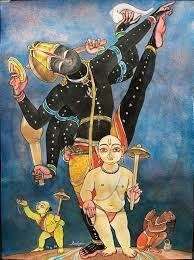
Lord Vishnu's fifth incarnation, is depicted in monumental size in the painting as he achieves victory over the three worlds with the help of his three feet, placing the first on swarga (heaven), the second on Prithvi earth, and the third on the head of the demon Bali to crush his conceit. He is therefore depicted as being enormous in height while the other characters are smaller because he is the winner of three worlds.
3. Bhava (Emotional Disposition):
- Bhava is a mental state that might be translated as feeling, emotion, mood, or devotion. paintings' ability to evoke strong emotions.
- This basically consists in drawing out the inner world of the subject; to help express its inner feelings.
Example - Durga mahishasura mardini painting by Tagore.
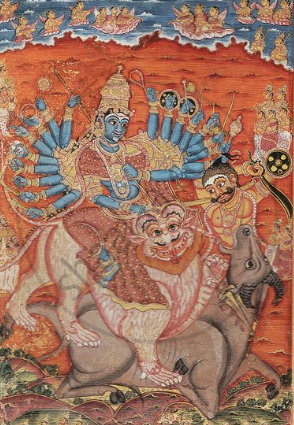
Goddess Kali and Lord Narasimha (a man-lion form of the god) create awe in the demons by horrified terror expressions in the picture of Durga Mahishasura mardini, where female hero Goddess Durga with power and proud present veer or victorious expressions.
Example - Shakuntala – Looks of Love by Raja Ravi Varma, 1870
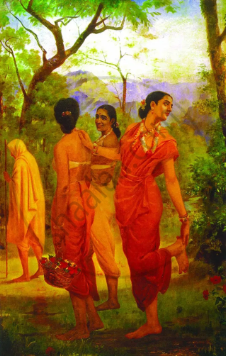
Varma painted Shakuntala as she pretends to remove a thorn from her foot. Secretly, Shakuntala is looking for her lover, Dushyantha.
4. Lavanya – Yojanam (Gracefulness in Composition):
- It is the infusion of grace.
- Infusion of grace is planning to create a beautiful and graceful environment, along with the beauty of the character.
- The emotive and lyrically graceful portrayal of the painting as a work of art embodies grace, beauty, charm, and sensitivity while also illuminating its spectators.
- The motive is to bring about a sense of beauty in a dignified and organized manner.
- While pramanani is for stringent proportions, and the bhava is for expressing movement. But, Lavanya yojanam is for controlling the over expression of both.
Example: Radha & Krishna with gopis, Pahari miniature, India
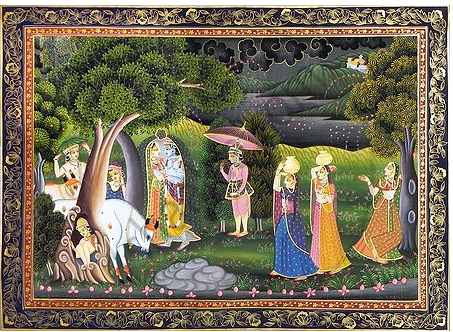
The beauty and charm are rendered in the Pahari painting of Bhagavata series where the romance of Radha and Krishna flows in the woods and greens.
5. Sadrishyam (Similitude):
- This is perhaps the most challenging task of creating a painting.
- Sadrishya suggests the degree to which a depiction is similar to an artist's vision or the subject itself. In a way, it is also a way of depicting similitude.
- It enhances the character of any individual and makes him complete in itself.
Example - mriganayani (eyes like deer eyes), the nose should be like an elephant trunk, thighs should be like a banana trunk, fingers like lotus petals, lips like fresh busted flowers, etc.
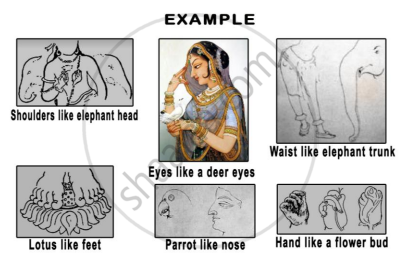
5. Varnakabhangam (Colour Differentiation):
- It is an artistic way of making use of the brush and colors.
- The term translated means the way a subject is being drawn and colored. So, obviously, there shall be the use of brush and pigments.
- What this principle focuses on, is the way the strokes are being applied to a canvas and the knowledge of the artist about the different colors.
- For example, Red is assigned with furious and yellow with heroic, white colour with comic, blue and black are associated with erotic and terrible.
